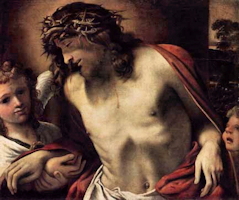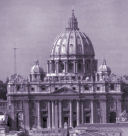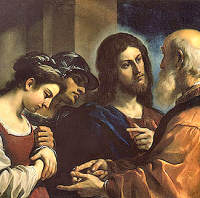Make your gift today!
Help keep Catholics around the world educated and informed.
Already donated? Log in to stop seeing these donation pop-ups.
» Enjoy our Liturgical Seasons series of e-books!
Entrance Antiphon, Cf. Ps 43 (42):1-2:
Give me justice, O God, and please my cause against a nation that is faithless. From the deceitful and cunning rescue me, for you, O God, are my strength.
"Let the one among you who is without sin be the first to throw a stone at her." Jesus did not deny the Scribes and Pharisees the right to carry out this prescription of the Law, but he insisted on one condition, namely, that they have no sin on their consciences. When Jesus and the woman were left alone, he looked up and said, "Woman, where are they?" Ironically, the self-righteous observers of the Law, so eager to throw stones, could not measure up to the requirement that Jesus had laid down.
Previously called "Passion Sunday," this Sunday marks the beginning of Passiontide, a deeper time of Lent. This is the third Sunday of the scrutinies for the preparation of adult converts, and the final Sunday of Lent before the beginning of Holy Week. The Liturgy of the Word of this day speaks of re-creation, resurrection, and new life.
Today the option of covering of sacred images is practiced. The rubrics in The Third Edition of the Roman Missal states,
In the Dioceses of the United States, the practice of covering crosses and images throughout the church from this Sunday may be observed. Crosses remain covered until the end of the Celebration of the Lord’s Passion on Good Friday, but images remain covered until the beginning of the Easter Vigil (Fifth Sunday of Lent, p. 256).
Sunday Mass Readings, Year C:
The First Reading is taken from the Book of the Prophet Isaiah, 43:16-21. Last week we heard of the conclusion of the exodus from Egypt; the first Passover celebration in the land of Canaan. This week we look forward to a new exodus that God promises through the prophet Isaiah. The new exodus promises to be far more wonderful than the first. God promises to restore His people after they have suffered in exile.
The Second Reading is from the Letter of St. Paul to the Philippians, 3:8-14, and is a warning to the Philippians about false teachers; Judaizers who would try to hang on to the old ways while at the same time claiming to be Christians. The Judaizers taught that in order to be a Christian, you first had to be a Jew: to be circumcised and to obey all 613 Old Covenant commandments. This question, whether or not Gentile converts to Christianity must first become full and legal Jews, prompted the Council of Jerusalem.
The Gospel is from St. John, 8:1-11 and is about the woman caught in adultery. "The two of them were left on their own, the wretched woman and Mercy. But the Lord, having smitten them with the dart of injustice, does not even deign to watch them go but turns his gaze away from them and once more writes on the ground with his finger. But when the woman was left alone and they had all gone, he lifted up his eyes to the woman. We have already heard the voice of justice; let us now hear the voice of gentleness. I think that woman was the more terrified when she heard the Lord say, 'Let him who is without sin among you be the first to throw a stone at her,' . . . fearing now that she would be punished by him, in whom no sin could be found. But he, who had driven away her adversaries with the tongue of justice, now looking at her with the eyes of gentleness, asks her, 'Has no one condemned you?' She replies, 'No one, Lord.' And he says, 'Neither do I condemn you; I who perhaps you feared would punish you, because in me you have found no sin.' Lord, can it be that you favour sinners? Assuredly not. See what follows: 'Go and sin no more.' Therefore, the Lord also condemned sin, but not the woman' (St Augustine, In Ioann. Evang., 33, 5-6).
Jesus, who is the just One, does not condemn the woman; whereas these people are sinners, yet they pass sentence of death. God's infinite mercy should move us always to have compassion on those who commit sins, because we ourselves are sinners and in need of God's forgiveness.
—The Navarre Bible—St. John, Year C
Meditation—Pushing On
 Now we come to the solemn weeks of Passiontide. Swiftly, swiftly go the days, and in this final stretch of Lent the devil is very busy. He gets busier and busier. The Gospel of the first Sunday said that the devil left our dear Lord “until an opportune time” (Lk 4:13). The devil is full of diabolical zeal to push on quickly to what he wants to have. What does he want? It is that we should be despondent, that we should feel, “Oh, what is the use?” after all the misspent graces of this Lent, all the things that seem to be going wrong. Knowing that, God inspired the Apostle to exhort us in today’s Second Reading to strain forward. I like the old translation which said “push on” (see Phil 3:13). Not “walk on” or “run on”, but push, which means to put the things that are in your way out of the way. Let us in our meditation and our prayer this coming week see what we need to push out of the way.
Now we come to the solemn weeks of Passiontide. Swiftly, swiftly go the days, and in this final stretch of Lent the devil is very busy. He gets busier and busier. The Gospel of the first Sunday said that the devil left our dear Lord “until an opportune time” (Lk 4:13). The devil is full of diabolical zeal to push on quickly to what he wants to have. What does he want? It is that we should be despondent, that we should feel, “Oh, what is the use?” after all the misspent graces of this Lent, all the things that seem to be going wrong. Knowing that, God inspired the Apostle to exhort us in today’s Second Reading to strain forward. I like the old translation which said “push on” (see Phil 3:13). Not “walk on” or “run on”, but push, which means to put the things that are in your way out of the way. Let us in our meditation and our prayer this coming week see what we need to push out of the way.
What is impeding our swiftly moving toward a deeper union with our crucified Lord than ever before? What do we need to push out of the way? It is usually not polite to push people or things out of our way. But spiritually that is what I should do when the interior obstacles are impeding me from moving swiftly: give them one good push that will send them reeling. There is just one person to whom I need to give a good push—myself and my attachment to myself. Let’s be very “pushy” in this week. We do not usually use that colloquial word in a very pleasant way; but in the way I am speaking now, out of the love and the eagerness of my heart, it is different. In this way it is wonderful to be really “pushy”.
Isaiah is telling us that we are a people that God formed for himself so that we might announce his praise (see Is 43:21). When, with the strength of grace, we have pushed out of our way what does not belong there, what impedes our progress into the heart of Jesus, then we can each of us be the person that he formed for himself to announce his praise. We can announce it in so many ways to one another. Every act of virtue, every smile, every act of love, every act of mercy and forgiveness announces his praise, because it is all due to him. We can do nothing good of ourselves. But “I can do all things him who strengthens me” (Phil 4:13). Every good thing that I allow his grace to achieve in me announces his praise.
I announce his praise and show what his mercy can achieve, what his grace can do, by my humility and my thankfulness in being forgiven, my joy in being allowed to go on living, my wonder that God has not wiped me out yet! God has not given up on me.
Again in Philippians, Saint Paul tells us “to know him and the power of his resurrection and [the] sharing of his sufferings by being conformed to his death” (Phil 3:10, NAB); or, in another translation, “by being formed into the pattern of his death”. His death leads to his Resurrection, and our own little deaths united with his can lead to our resurrection. We have to be formed in that pattern of his death and rising. What is that pattern? It is a pattern that keeps repeating the motif. He forgives, and then he forgives again. He shows mercy, and then he shows mercy again and again. He places his hope in us, and, despite all our counter-evidence, he hopes and hopes again. Despite our poor response to his love, he loves and loves again, on and on and on. This is his pattern. We can only push on in his pattern of death and rising, that pattern of mercy, of forgiving, of hoping, and of loving.
—Mother Mary Francis, A Time of Renewal

Fifth Sunday of Lent
Station with San Pietro in Vaticano (St. Peter in the Vatican):
In the 1962 Roman Missal, this would be Passion Sunday. All Station Churches for Sundays in Lent were held at basilicas of Rome, but the major basilicas particularly for the first, fifth and sixth Sundays of Lent. The original church was erected on the site of the Roman Circus built by the Emperor Caligula around the year A.D. 40. and where St. Peter was crucified and placed upside down at his request and later buried here.
From the PNAC: "Rightly has Pope Benedict XVI spoken of this basilica as the heart of the Roman Church, as St. John Lateran is the head. It is here that the Church honors her first shepherd in this city, and here that since his martyrdom she has celebrated both his witness and the God he served. While the basilica before us is relatively modern as far as the history of Christianity goes, being completed only in 1626, Christians have been coming to this site to ask for his intercession since shortly after the death of the Prince of the Apostles, as messages left by them on the wall of his grave attest." For further information on the Station Churches, see The Stational Church.
See also Churches of Rome Info.

Fifth Sunday of Lent
Station with San Pietro in Vaticano (St. Peter in the Vatican):
In the 1962 Roman Missal, this would be Passion Sunday. All Station Churches for Sundays in Lent were held at basilicas of Rome, but the major basilicas particularly for the first, fifth and sixth Sundays of Lent. The original church was erected on the site of the Roman Circus built by the Emperor Caligula around the year A.D. 40. and where St. Peter was crucified and placed upside down at his request and later buried here.
From the PNAC: "Rightly has Pope Benedict XVI spoken of this basilica as the heart of the Roman Church, as St. John Lateran is the head. It is here that the Church honors her first shepherd in this city, and here that since his martyrdom she has celebrated both his witness and the God he served. While the basilica before us is relatively modern as far as the history of Christianity goes, being completed only in 1626, Christians have been coming to this site to ask for his intercession since shortly after the death of the Prince of the Apostles, as messages left by them on the wall of his grave attest."
For more on San Pietro in Vaticano, see:
- Rome Art Lover
- Roman Churches
- PNAC
- Aleteia
- St. Peter's Basilica Info
- Station Church
- The Catholic Traveler
For further information on the Station Churches, see The Stational Church.






